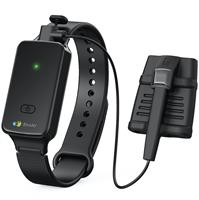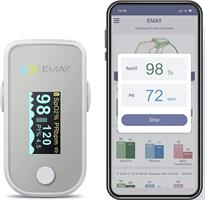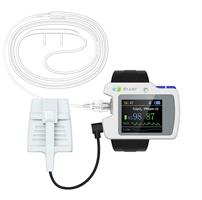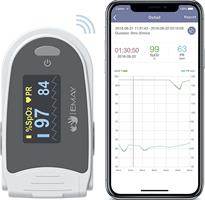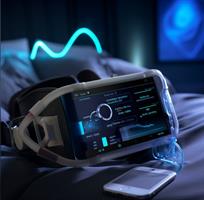When you buy through our links, we may earn a commission. An affiliated entity may offer products or services. Learn more.
Monitoring your blood oxygen levels and heart rate during sleep is crucial, especially for those with sleep apnea or other respiratory conditions.
Finding the best overnight pulse oximeter for your needs and budget has never been easier. Using one of these devices lets you learn about your sleep health without needing an expensive or time-consuming doctor's visit.
If you're not getting enough oxygen after using one of these devices, please see a doctor.
In this article, we’ll guide you through the top overnight pulse oximeters in 2024, helping you make an informed decision based on your needs and budget.
Top Three Overnight Pulse Oximeters for Accurate Health Monitoring
To help you find the right pulse oximeter for your needs, we have curated a list of the top three overnight pulse oximeters that excel in different areas:
-
Best Overall: SleepO2 Wrist Sleep Oxygen Monitor
-
Best Value: EMO-60 Bluetooth Pulse Oximeter
-
Most Advanced At Home Monitoring: SleepO2 Pro Sleep Apnea Monitor
-
Best Fingertip Device: EMO-80 Sleep Oxygen Monitor
Best Overall: SleepO2 Wrist Sleep Oxygen Monitor
Price: $99.00
Check Latest Price for: SleepO2
Video
Specifications
-
Brand: EMAY
-
Compatible Devices: Smartphones
-
Battery Life: 12 Hours
-
Lightweight: Yes, at only 20 grams
-
Memory: Built-in, 48 hours of data storage
-
App: Intelligent iOS/Android App for data transfer and analysis
Pros
-
Continuous SpO2 and pulse rate recording
-
Comfortable wristband design with a patented silicone sensor
-
Stand-alone device with built-in memory
-
Professional summary report and raw data export capabilities
-
Rechargeable lithium battery with 12 hours of battery life
Cons
-
Not suitable for real-time monitoring on the device; sync needed for data review
-
Some users may find syncing with the app initially challenging
Overview
The EMAY SleepO2 Wrist Sleep Oxygen Monitor excels in sleep oxygen monitoring with its:
-
Ultra-soft sensor probe for all-night comfort Ample built-in storage for independent tracking
-
Easy data transfer and detailed sleep report generation through a user-friendly app
-
Lightweight design and rechargeable battery, making it ideal for overnight monitoring
Rating
-
Price: 4.5/5
-
Design: 4.5/5
-
Accuracy: 4/5
-
Ease of Use: 4/5
EMO-60 Bluetooth Pulse Oximeter: Best Value
Price: $29.99
Check Latest Price for: EMO-60
Video
Specifications
-
Accurate measurement of blood oxygen levels (SpO2), pulse rate, strength, and waveform.
-
Large OLED screen for easy reading.
-
Free iOS/Android App for real-time data display and storage.
-
App includes historical data review, graphic trends, and report analysis.
-
Easy export of PDF reports and CSV files for medical reference.
-
FDA Cleared.
-
1-Year Warranty.
-
Intended for sports, aviation, and wellness use (not for sleep monitoring).
Customer Reviews
-
Amber Hollenback (11/01/2023): Appreciates the ability to monitor heart rate fluctuations and share data with a doctor.
-
VILMA. A ROBLETO (10/13/2023): Praises the product's effectiveness and app integration, especially for sleep apnea monitoring.
-
Amazon Customer (10/04/2023): Likes the professional readings and Bluetooth technology for sharing data with doctors.
Pros
-
Real-time monitoring with a comprehensive app.
-
Historical data analysis and report generation.
-
User-friendly interface and easy data sharing.
Cons
-
Not suitable for sleep monitoring.
Overview
The EMO-60 Bluetooth Pulse Oximeter offers advanced monitoring of vital health metrics, enhanced by its Bluetooth connectivity and comprehensive app support. It's ideal for individuals engaged in sports, aviation, and wellness activities who need to track their blood oxygen and pulse rate. The device's ease of use and data export capabilities make it a valuable tool for sharing health information with healthcare professionals. Although it can be used for overnight sleep monitoring, it's not designed only for it.
Rating
-
Price: 4.5/5
-
Design: 4/5
-
Accuracy: 4/5
-
Ease of Use: 4/5
Most Advanced At Home Monitoring: SleepO2 Pro Sleep Apnea Monitor
Price: $199.00
Check Latest Price for: SleepO2 Pro
Video
Specifications
-
Wrist-worn device recording blood oxygen saturation, heart rate, and flow.
-
Comfortable silicone O2 sensor for overnight use.
-
Soft-touch tube for flow monitoring, minimizing discomfort.
-
Powerful PC software for data review and analysis (Windows only).
-
Rechargeable, with 8G data storage.
-
Includes device, oxygen sensor, nasal tubes, USB cable, power adapter, and user manual.
Customer Reviews
-
JTP (09/16/2023): Finds the device oversensitive in detecting apnea events, noting false positives while awake. Recommends a nasal/oral cannula for accurate readings.
-
M.D. (09/04/2023): Praises the device for accurate, easy-to-understand results and multiple-use flexibility.
-
Jon (08/21/2023): Easy to use, planning to compare with professional sleep monitoring equipment.
-
Jay How (08/19/2023): Purchased to validate extreme results from a doctor-ordered sleep study, experiencing common apnea symptoms.
Pros
-
Accurate monitoring of vital sleep health metrics.
-
Comfortable and non-intrusive design.
-
Comprehensive PC software for in-depth analysis.
-
Large data storage capacity.
Cons
-
Potential oversensitivity in apnea detection.
-
Limited to Windows PC for data analysis.
-
May not work effectively with CPAP machines.
Overview
The SleepO2 Pro Sleep Apnea Monitor is a comprehensive tool for monitoring sleep health, offering detailed insights into sleep apnea symptoms. Its comfortable design and advanced data analysis capabilities make it a valuable asset for individuals seeking to understand and manage their sleep apnea better. However, users should be aware of its potential oversensitivity and compatibility limitations with CPAP machines and non-Windows systems.
Rating
-
Price: 4/5
-
Design: 4.5/5
-
Accuracy: 4/5
-
Ease of Use: 4/5
Best Fingertip Device: EMO-80 Sleep Oxygen Monitor
Price: $59.00
Check Latest Price for: EMO-80
Video
Specifications
-
Brand: EMAY
-
Compatible Devices: Smartphones
-
Battery Life: Not specified
-
Lightweight: Yes
-
Memory: Built-in, 40 hours of data storage
-
App: Free iOS/Android App for data review, analysis, and CSV file export
Pros
-
Stores overnight blood oxygen saturation levels & heart rate
-
Record first, sync later functionality
-
Detailed sleep report with analysis & trends
-
Accurate and reliable readings on a large digital LCD screen
-
California based support team for assistance
Cons
-
Requires syncing with smartphone for data review
-
Not intended for medical use, only for sport and aviation
Overview
The EMAY Sleep Oxygen Monitor is designed for sleep monitoring, featuring:
-
40 hours of built-in memory for continuous data recording
-
Stand-alone device capability with later sync option
-
Accurate and reliable data display on a rotating LCD screen
-
User-friendly app for data analysis and historical review
-
Dedicated customer support team
Rating
-
Price: 4.5/5
-
Design: 4.5/5
-
Accuracy: 4/5
-
Ease of Use: 4/5
Understanding Pulse Oximeters: A Comprehensive Guide
Pulse oximeters are medical devices used to measure the oxygen saturation level of a patient’s blood. The most common type of pulse oximeter for home use is the fingertip pulse oximeter, but there are also continuous reading oximeters, personal use oximeters, and hospital-grade pulse oximeters available.
Utilizing a pulse oximeter offers the benefit of monitoring and measuring blood oxygen and pulse rate from the comfort of one’s home, tracking oxygen levels regularly for individuals with lung or heart conditions, and detecting a decline in lung function.
Correct positioning of the device, removal of any nail polish, warming the fingers or toes, and the user’s stillness are all vital when using a pulse oximeter. These factors contribute to an accurate reading, which is indispensable for dependable health monitoring.
Pulse oximeters have become increasingly popular as an essential health monitoring tool, particularly for those with sleep apnea or other respiratory conditions. By understanding the different types of pulse oximeters, their functions, and benefits, you can make an informed decision when selecting the right device for your needs.
EMAY Discounts
At Snoring Mouthpiece Review, we have partnered with EMAY to offer you 20% off!
Use code: TH31F230YT3W to get your discount.
Snoring and Sleep Apnea Monitoring with Pulse Oximeter
Pulse oximeters can help monitor snoring and sleep apnea by tracking blood oxygen levels and heart rate during sleep.
Sleep apnea, a condition in which breathing is repeatedly interrupted during sleep, can lead to dangerously low blood oxygen levels. Monitoring these levels with a pulse oximeter can provide valuable insight into the severity of sleep apnea and the effectiveness of treatment.
Some pulse oximeters, like the Wellue O2 Ring Sleep Tracker, feature a vibration alarm that alerts users when their oxygen saturation levels drop below a certain threshold. This can help individuals with sleep apnea address their condition more effectively and make necessary adjustments to their treatment plan.
By using one of these devices, you can easily see if a device like a snoring mouthpiece helps your breath better at night.
Overall, pulse oximeters can serve as a useful tool for monitoring snoring and sleep apnea, providing individuals with valuable data to better understand and manage their condition.
Key Features to Look for in an Overnight Pulse Oximeter
Several key features should be considered when choosing an overnight pulse oximeter, as they can impact the device’s performance and its suitability for your needs.
The key considerations when choosing a pulse oximeter are:
-
Pulse oximeter accuracy: The accuracy of a pulse oximeter is paramount as it directly impacts the reliability of the readings.
-
Comfort: Comfort shouldn’t be overlooked, especially for overnight use, as discomfort can disrupt your sleep.
-
Ease of use: A user-friendly device will facilitate more effective health monitoring, hence, ease of use is a significant consideration. Compatibility with mobile devices can be important for some.
Other factors to consider include the data display, which should be clear and easy to read, and compatibility with mobile devices for tracking and monitoring your health data. By taking these features into account, you can select the best overnight pulse oximeter based on your individual needs and preferences.
How to Choose the Right Pulse Oximeter for Your Needs
Selecting the right pulse oximeter depends on your individual needs, preferences, and budget. To determine the best device for you, consider factors such as your lifestyle, the specific features you require, and the price range you’re comfortable with.
For example, if you’re looking for a budget-friendly option, the Holfenry Pulse Oximeter is a reliable and cost-effective choice.
If comfort and detailed sleep analysis are your top priorities, the Wellue O2 Ring Sleep Tracker may be your best bet. For those who prefer a tech-savvy device, the iHealth Air Wireless Fingertip Pulse Oximeter offers advanced technology and compatibility with iOS and Android devices.
By evaluating the various options available and considering their unique features, you can make an informed decision and choose the right pulse oximeter that best suits your needs.
Summary
In conclusion, overnight pulse oximeters are essential tools for monitoring blood oxygen levels and heart rate during sleep. By understanding the different types of pulse oximeters, their functions, and key features, you can make an informed decision when selecting the right device for your needs.
Whether you’re seeking a budget-friendly option, a device focused on comfort and detailed sleep analysis, or a tech-savvy pick, there’s an overnight pulse oximeter out there to suit your individual requirements.
Frequently Asked Questions
Is pulse oximeter accurate when sleeping?
Pulse oximetry can be an effective method to identify possible sleep disorders, however it is not a conclusive test and may require additional testing before a diagnosis can be given.
What is a normal overnight pulse oximeter?
A normal overnight pulse oximeter measures the amount of oxygen in your blood, with an average healthy reading being 96%. This ensures that your brain is receiving the oxygen it needs during sleep.
How can I monitor my oxygen levels while sleeping?
Monitoring your oxygen levels while sleeping is simple with the O2 Ring. This wearable device tracks your blood oxygen level and heart rate for accurate readings.
How much do at home pulse oximeters cost?
Pulse oximeters typically cost between $40 and $250.
What is a pulse oximeter?
A pulse oximeter is a medical device used to measure the oxygen saturation level of a patient's blood, enabling healthcare providers to assess a patient's breathing and circulation quickly and easily.
Can a pulse oximeter help monitor snoring and sleep apnea?
Yes, pulse oximeters can help monitor snoring and sleep apnea by tracking blood oxygen levels and heart rate during sleep, making it an effective monitoring tool.
References
- The uses of overnight pulse oximetry. https://www.ncbi.nlm.nih.gov/pmc/articles/PMC7065557/
- Overnight pulse oximetry for obstructive sleep apnea screening among patients with snoring in primary care setting: Clinical case report. https://www.ncbi.nlm.nih.gov/pmc/articles/PMC6259496/
- Accuracy of overnight pulse oximetry in diagnosing moderate to severe obstructive sleep apnoea. https://erj.ersjournals.com/content/48/suppl_60/OA4794
